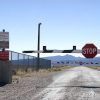Alaska, often known as the Last Frontier, has been a strategic location for the United States Air Force and other branches of the armed forces. This has led to speculation about a secret military base in Alaska. But is there any truth to the claims? Let’s find out.
The Strategic Importance of Alaska
Alaska’s strategic location, with its relatively flat terrain and proximity to the West Coast, became evident following the Pearl Harbor attack. Recognizing this potential, the U.S. government began establishing regional military bases. Ladd Field, now known as Fort Wainwright, existed during this period. Its location near Fairbanks provided an ideal spot for a refueling station and training ground for troops.
Military Expansion during World War II
World War II marked a significant expansion of military installations in Alaska. As the war progressed, the United States realized the importance of having a strong military presence in the region to counter potential threats from the Pacific. This led to several new bases, transforming Alaska into a militarized zone.
Alaska’s Role in World War II
In “Alaska at War, 1941-1945: The Forgotten War Remembered,” edited by Fern Chandonnet, Alaska’s role during World War II is explored in detail.
The book provides a comprehensive account of how the state’s landscape changed with the establishment of military bases and the influx of servicemen. It also discusses these changes’ impact on Alaska and the most significant state’s indigenous communities.
Secret Military Base in Alaska: Fact or Fiction?
The Rumors and Speculations
Over the years, rumors of a secret military base in Alaska have circulated, fueled by the state’s remote location and the presence of several military installations. These rumors often depict the supposed base as a hotbed of covert operations and advanced technology. However, despite the intrigue and speculation, the Department of Defense has consistently denied these rumors.
Analyzing the Evidence
Critics argue that the lack of concrete evidence points to the non-existence of such a base. They claim that the secrecy surrounding military activities in Alaska can be attributed to routine defense operations rather than clandestine activities.
The Government’s Stance
The U.S. government maintains that all its military installations in Alaska, including Eielson Air Force Base and Clear Air Force Station, operate within the public domain. While these bases carry out sensitive operations and remain crucial to national security, they are not classified as “secret.” Any suggestion otherwise remains within the realm of speculation and conspiracy theories.
Concealing in Alaska’s Wilderness
The Alaskan Bush: Much land of Alaska is covered by dense forests, often referred to as “the Alaskan bush.” These areas are so remote and inaccessible that they could theoretically cover a hidden base. However, the logistical challenges of building and supplying a base in such terrain would be immense.
Mountain Ranges: Alaska has numerous mountain ranges, including the Alaska and Brooks Range. These rugged, often snow-capped mountains could conceal a secret base, mainly if it were underground.
Arctic Tundra: The vast, flat landscapes of Alaska’s Arctic tundra could hide a base in plain sight. A low-profile installation could blend into the surrounding environment, especially in winter when the area is covered in snow.
Secluded Islands and Coastal Regions
Aleutian Islands: This chain of islands stretches from Alaska to Russia, with many uninhabited islands. Their remote location and difficult weather conditions could make them a plausible place for a hidden base.
Coastal Inlets and Fjords: Alaska’s coastline has secluded inlets and fjords. These locations, surrounded by cliffs and often shrouded in mist, could provide a natural cover for covert operations.
Underground Facilities
Subterranean Bases: Given Alaska’s varied terrain, an underground base could be possible. Such a facility could utilize natural features such as caves or be built into a mountainside to minimize its visibility.
However, it’s essential to note that while these locations might offer concealment, creating a secret base would pose significant technological, logistical, and legal challenges. In today’s world of advanced satellite imagery and stringent military regulations, maintaining such a base secretly would be highly unlikely.
The Crucial Role of the United States Air Force in Alaska
Alaska’s strategic location and vast airspace make it an ideal place for various branches of the U.S. military, particularly the Air Force. Installations such as Elmendorf Air Force Base and Eielson AFB play crucial roles in the nation’s defense. These bases provide logistical support for offensive operations and serve as the first line of defense against potential attacks.
Elmendorf Air Force Base: An Integral Military Installation
Elmendorf AFB, located near Anchorage, is one of Alaska’s largest and most important Air Force installations. Home to various aircraft, this base provides essential airpower and support to U.S. and allied forces. Its strategic location makes it a key player in maintaining peace and stability in the Pacific region.
Eielson Air Force Base: A Closer Look
The Establishment of Eielson Air Force Base
Eielson AFB, named after famed aviator Carl Ben Eielson, is nestled near Moose Creek in the Denali Borough. Established during the height of the Cold War, its primary mission was to provide close air support for ground forces. Over the years, the base has evolved, but its importance in supporting U.S. military operations remains undiminished.
Eielson AFB: A Pillar of the Alaskan Air Command
Today, Eielson AFB is an essential part of the Alaskan Air Command, providing crucial capabilities such as air superiority, global strikes, and rapid global mobility. Its strategic location allows the U.S. to project power across the Pacific, making it a vital asset in the nation’s defense strategy.
Clear Air Force Station: A Strategic Asset
Clear Air Force Station: The Early Warning System
Located off the Richardson Highway, Clear Air Force Station is part of an early warning radar network to detect intercontinental ballistic missiles. Its crucial role in the nation’s defense system cannot be overstated, providing a critical line of defense against potential threats.
Clear Space Force Station: Monitoring the Earth’s Atmosphere
In 2020, Clear Air Force Station was renamed Clear Space Force Station, reflecting its evolving role in space defense. Today, the station plays a critical role in monitoring the Earth’s atmosphere, tracking thousands of objects daily, and providing essential data for maintaining space situational awareness.
World War II: Alaska’s Role and Impact
The Overlooked Theater of Operations
Although often overlooked in mainstream historical narratives, Alaska played a pivotal role during World War II. As detailed in Brian Garfield’s book “The Thousand-Mile War,” the state was a significant theater of operations during the conflict. Its strategic location made it a key player in the Pacific war efforts.
The Establishment of Air Force Bases
The war years saw the establishment of nine military bases and several air force bases in Alaska. These installations served not only as launch pads for offensive operations but also as critical defensive posts. The infrastructure developed during this period laid the groundwork for the state’s continued military importance, setting the stage for Alaska’s prominent role in the Cold War.
Decoding the Mystery: Analyzing Claims of a Secret Base
The Persistence of Rumors
Despite the lack of concrete evidence, rumors of a secret military base in Alaska have persisted for decades. This enduring fascination can be attributed to the state’s vast, remote landscapes, harsh weather conditions, and its aura of mystery. Alaska’s remoteness and rugged terrain make it an ideal setting for intrigue and speculation.
The Role of Popular Culture
Popular culture has played a significant part in perpetuating these rumors, with numerous books, films, and television shows depicting secret government installations in Alaska. Although not based on fact, these fictional representations have added fuel to the fire of speculation.
Potential Reasons for Secrecy
Strategic Location
If a secret military base does exist in Alaska, its strategic location near the North Pole and the Pacific Ocean would be a likely reason. The state’s position makes it valuable for monitoring global military activities and launching strategic operations if necessary.
The Harsh Alaskan Wilderness
In his book “Arctic Homestead,” Norma Cobb discusses the harsh realities of life in the Alaskan wilderness. This extreme environment could provide an ideal cover for covert operations, with the severe weather and rugged terrain as natural deterrents to unwanted visitors. The isolation and inaccessibility of much of Alaska’s landscape make it a plausible location for activities that require a high level of secrecy.
Consequences of Secrecy
The Breeding Ground for Mistrust
While often necessary for national security and operational success, secrecy can sometimes lead to unintended consequences. One significant fallout is the potential for breeding mistrust between the public and the military. Information withheld can create a perception of intentional obfuscation or manipulation, leading to skepticism and doubt about the military’s actions and intentions.
Speculation and Conspiracy Theories
Excessive secrecy can also lead to rampant speculation and the birth of conspiracy theories. For instance, the HAARP (High-Frequency Active Auroral Research Program) in Alaska, a research program aimed at studying the ionosphere, has been the subject of numerous conspiracy theories. Accusations range from the program being a superweapon capable of controlling the weather to it being a mind control tool. Despite these theories being debunked by scientists, they persist due to the secretive nature of the project.
The Balance Between Secrecy and Transparency
Balancing secrecy for national security with the public’s right to know is delicate. While some information must be kept secret to protect national interests, excessive secrecy can undermine public trust. Therefore, maintaining this balance is crucial to ensure public support and confidence in the military’s actions.
Conclusion
Alaska’s distinct geographical location, coupled with its rich military history, has long fueled speculation about the existence of clandestine military installations. No concrete evidence has surfaced to confirm these theories despite the intrigue and conjecture. Instead, what remains unequivocal is Alaska’s significant contribution to the United States defense strategy.
From its pivotal role during World War II, as highlighted in Brian Garfield’s “The Thousand-Mile War,” to its continued relevance in modern defense operations, Alaska stands as a testament to strategic foresight. Its military bases, such as Eielson AFB and Clear Air Force Station, continue to serve vital functions in national security.
As we look to the future, Alaska’s strategic importance is unlikely to diminish. Its proximity to potential hotspots, vast airspace, and challenging terrain position it as a critical component of the United States defense architecture. Whether or not a secret base exists within its borders, Alaska’s prominence on the military stage is indisputable and will likely continue for the foreseeable future.
Sources:
- Chandonnet, Fern, ed. Alaska at War, 1941-1945: The Forgotten War Remembered. University of Alaska Press, 2007.
- Garfield, Brian. The Thousand-Mile War: World War II in Alaska and the Aleutians. University of Alaska Press, 1995.
- Cobb, Norma. Arctic Homestead: The True Story of One Family’s Survival and Courage in the Alaskan Wilds. St. Martin’s Griffin, 2003.
Recommended Further Reading:
Auto Amazon Links: No products found.



